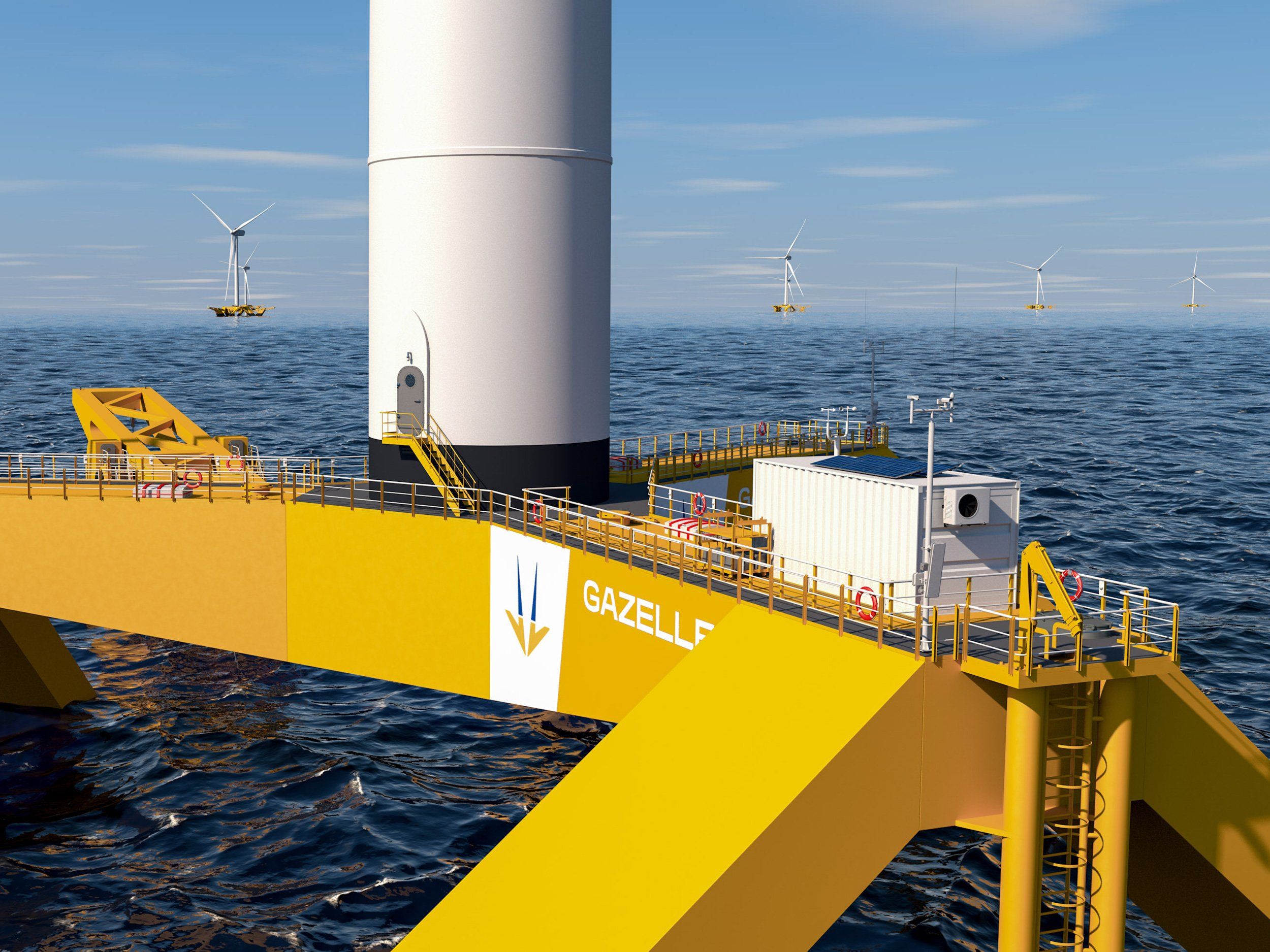Floating Wind Farms Aim for Open Ocean
Deep waters hold 80 percent of Earth’s wind resources
With nothing in their path to slow them down, winds over the ocean can consistently blow at higher speeds than is possible on land. This makes them attractive to harness for electricity. But the floating wind turbines that are needed for deep waters face salty wind gusts and large waves, not to mention the immense challenge of installing them in the first place.
Dublin-based Gazelle Wind Power says it has a novel solution. The company recently unveiled a floating wind-platform design that is modular and uses less steel than its competitors, making it cheaper, lighter, and easier to install. “Using Gazelle’s solution, a 1-gigawatt offshore wind farm can save more than 142,000 metric tonnes of steel and reduce emissions of over 260,000 tonnes of carbon dioxide emissions,” says says Gazelle’s chief technology officer, Jason Wormald.
Offshore wind is gaining momentum around the world. The sector mostly relies on turbines anchored to the seabed with fixed foundations, which cannot be used in waters deeper than 60 meters. But around 80 percent of the world’s offshore wind resources are in areas with deeper waters, according to the Global Wind Energy Council.
“Deploying the largest, most powerful turbines is the only way to reach decarbonization targets.”
—Jason Wormald, Gazelle Wind Power
So the wind industry is slowly moving farther from shore. Three floating wind projects came on line in 2021, totaling 57.1 megawatts. The world’s largest floating wind farm, the Hywind Tampen, by Norwegian energy firm Equinor, produced its first power late last year. In September 2022, the Biden administration unveiled its Floating Offshore Wind Shot, which aims to “reduce the costs of floating technologies by more than 70 percent by 2035, to US $45 per megawatt-hour” and increase capacity to 15 GW by 2035, enough to power 5 million homes. Floating wind installations are really going to take off starting in 2027, according to research provider BloombergNEF, mostly in Europe and the United States.
Being far from shore, floating wind farms solve the not-in-my-backyard issue. But they come with enormous engineering challenges. Platforms for these farms need to support massive 15-MW or larger turbines, says Wormald. Larger turbines make installation more cost-effective than installing several smaller turbines, he says. But many platforms being used or assessed today “require large quantities of steel, have inefficient mooring systems that negatively impact the seabed and marine environments, and require specialized vessels, cranes, and infrastructure to assemble and transport.”
Several companies are developing innovative floating wind platforms for use in deep waters. Many of these borrow from oil rig designs for offshore drilling. About 80 percent of projects plan to use semisubmersible platforms, structures that float partly underwater and are moored to the seabed via chains. Another popular design is the tension-leg platform, which is vertically moored at every corner by stiff tethers.
“Most of Gazelle’s competitors utilize legacy solutions from the oil and gas industry,” Wormald says. “Gazelle’s solution was solely designed with the floating offshore wind industry in mind.”
The company’s unique design combines the best features of semisubmersible and tension-leg platforms. The key features are pivoting arms and a dynamic mooring system. The platform is anchored to the ocean floor by vertical mooring lines, but they are attached via pivoting arms to a counterweight suspended in the water directly beneath the center of the platform. The platform moves with the wind and waves, but the counterweight system balances the motions and forces and keeps the turbine’s pitch low, keeping it stable and helping it work efficiently in the face of high winds and waves.
The platform is smaller and lighter than the conventional semisubmersible design, according to Gazelle. It uses much less steel, which reduces costs by 30 percent. Plus, the system is modular, so it can be installed easily and more quickly without needing specialized equipment. And it could be scaled up for turbines up to 20 MW in size.
So far, the company has tested its design on a 1:60-scale model of a 10-MW turbine platform at the University of Cantabria’s Environmental Hydraulics Institute, in Spain. The tests’ success gained the company an approval of technical feasibility for an offshore wind platform from DNV, a Norway-based certification provider specializing in marine and offshore systems.
Gazelle is now embarking on a pilot-scale project off the coast of Portugal with the renewable energy developer WAM Horizon. The company has not revealed the size or timeline of the plant yet. But Wormald says the Gazelle design “can be tailored to any size turbine in any operating environment. Deploying the largest, most powerful turbines is the only way to reach decarbonization targets. Innovative solutions like Gazelle’s will allow these megaturbines to operate efficiently in deeper seas where wind power is stronger and less intermittent.”
- UK Approves World's Largest Offshore Wind Farm ›
- For the First Time, Offshore Wind Power Will Be Profitable Without Subsidies ›
- Wind-to-Hydrogen Production Reaches Deep Water - IEEE Spectrum ›
- Inside the Global Race to Tap Potent Offshore Wind - IEEE Spectrum ›
Prachi Patel is a freelance journalist based in Pittsburgh. She writes about energy, biotechnology, materials science, nanotechnology, and computing.
